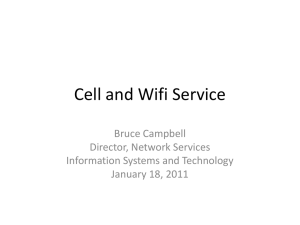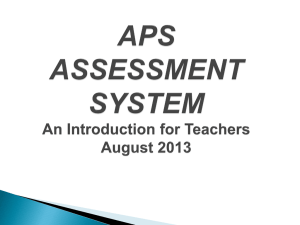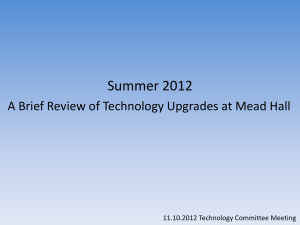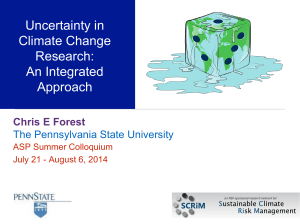Slides - Sigmobile
advertisement
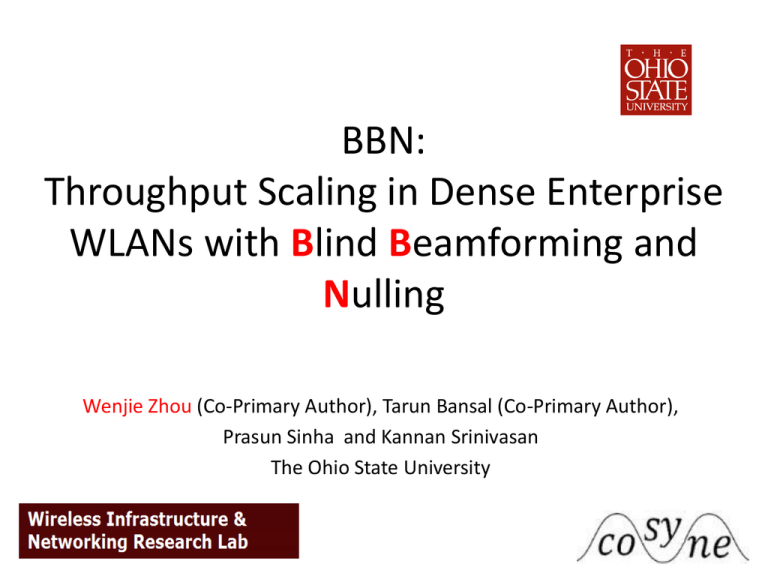
BBN: Throughput Scaling in Dense Enterprise WLANs with Blind Beamforming and Nulling Wenjie Zhou (Co-Primary Author), Tarun Bansal (Co-Primary Author), Prasun Sinha and Kannan Srinivasan The Ohio State University Changes in Uplink Traffic Traditionally, WLAN traffic: • downlink heavy • less attention to uplink traffic Recently, uplink traffic increased rapidly : • mobile applications Cloud Computing Code Offloading Online Gaming VoIP, Video Chat Sensor Data Upload 2 Can we scale the uplink throughput with the number of clients? Network MIMO Exchange raw samples AP1 C1 AP2 C2 AP3 C3 Huge bandwidth consumption MegaMIMO1 Does not apply to uplink : Clients do not share a backbone network [1] Rahul, H., Kumar, S., and Katabi, D. MegaMIMO: Scaling Wireless Capacity with User Demand. In Proc. of ACM SIGCOMM 2012. Interference Alignment1 • • • • C1 AP1 C2 AP2 C3 AP3 4 packet, 3 slots Enough time slots, everyone gets half the cake Exponential slots of transmissions, not suitable for mobile clients Heavy coordination between clients [1] Cadambe, V. R., and Jafar, S. A. Interference Alignment and the Degrees of Freedom for the K User Interference Channel. IEEE Transactions on Information Theory (2008). Existing interference alignment and beamforming techniques are not suitable to mobile uplink traffic. How can we bring the benefits of beamforming to uplink traffic? AP Density in Enterprise WLANs 1 CDF 0.75 0.5 (140,0.5) 0.25 0 50 100 150 Number of Access Points (APs) 200 BBN leverages the high density of access points 8 Omniscient TDMA Single Collision Domain Time Slot: 3 1 2 AP2 AP3 AP4 Switch AP1 x1 x2 C1 x3 C2 C3 Three Packets received in Three Slots Only one AP is in use 9 Blind Beamforming and Nulling Single Collision Domain h(1) 11x1 + h(1) 21x2 + h(1) 31x3 h(1) 12x1 + AP1 h(1) 22x2 + h(1) Time Slot: 1 32x3 AP2 h(1)14x1 + h(1)24x2 + h(1)34x3 AP3 Switch h(1)13x1 + h(1)23x2 + h(1)33x3 AP4 h(1)13 x1 h(1)33 h(1)23 x2 C1 x3 C2 C3 10 Blind Beamforming and Nulling Single Collision Domain Receives: a11x1 + s1h(1)21x2 + s1h(1)31x3 Receives: a12x1 + a22x2 + a32x3 AP2 AP3 AP4 Switch AP1 Time Slot: 2 Transmits: v3 (h(1)13x1 + h(1)23x2 + h(1)33x3) Transmits: v4 (h(1)14x1 + h(1)24x2 + h(1)34x3) 11 Blind Beamforming and Nulling Single Collision Domain Slot 1: h(1)11x1 + h(1)21x2 + h(1)31x3 Slot 1: h(1)12x1 + h(1)22x2 + h(1)32x3 Slot 2: a11x1 + s1h(1)21x2 + s1h(1)31x3 Slot 2: a12x1 + a22x2 + a32x3 (s1h(1)11-a11)x1 AP2 AP3 AP4 Switch AP1 Three Packets received in Two Slots 12 Number of APs Required • In a network with N 2 N 2 2 APs, APs in BBN can receive N uplink packets in two slots • 3 clients, 4 APs • 4 clients, 7 APs • 10 clients, 46 APs 13 Throughput Improvement • Previous Example Topology – APs in BBN receive three packets in two slots: an improvement of 50% • General Topology – Uplink throughput in BBN scales with the number of clients (N/2 packets per slot). – Half of the cake as in Interference Alignment • Always two slots • No coordination between clients 14 BBN Highlights • Leverages the high density of access points • All computation and design complexity shifted to APs • APs only need to exchange decoded packets over the backbone instead of raw samples 15 Further Optimizations to Improve SNR x1 Receivers AP2 AP1 Switch Transmitters x2, x3 AP4 AP3 C1 C2 C3 • Which subset of APs act as transmitters and which subset as receivers? • Which AP decodes which packet? BBN Approach: xi is decoded at the APj where it is expected to have highest SNR 16 Challenge 1/4: Synchronization of APs • To perform accurate beamforming, APs need to be tightly synchronized with each other • Solution: – SourceSync (Rahul et al., SIGCOMM 2010): synchronizes APs within a single collision domain – Vidyut (Yenamandra et al., SIGCOMM 2014): uses power line to synchronize APs in the same building 17 Challenge 2/4 : MultiCollision Domain • Not all APs may be able to hear each other directly • Solution: Make smaller groups where all APs in a single group can hear each other. 18 Distributed System Group Head Group Head • Within a group, all APs can hear each other • When one group is communicating, neighboring groups remain silent 19 Challenge 3/4 : Inconsistency in the AP density • Number of APs may be less than N 2 N 2 2 • Solution: Appropriate MAC layer algorithm that restricts the number of participating clients 20 MAC Timeline Keep Silent – Allow neighboring groups to transmit Uplink Uplink Time Slot 1 Approve A, B and C Notification Period Uplink Time Slot 2 ....... Poll Downlink ....... ....... Time Compute pre-coding vectors in the background 21 Challenge 4/4 : Robustness • Nulling is not always perfect. Can’t Subtract x1 Decoding Error x1 x1, x2 , x3 AP2 AP4 AP5 Switch AP1 x1 x2 C1 C2 x3 C3 22 Challenge 4/4 : Robustness • What if we have extra APs x1 x1, x2 , x3 AP2 AP3 AP4 AP5 Switch AP1 x1 x1 x2 C1 C2 AP6 AP7 x3 C3 23 Experiments Intended Signal = x1 Interference from x2, x3 AP2 AP3 AP4 USRP N210 Switch AP1 x2, x3 x2 x1 C1 C2 x3 C2 24 Throughput 1.48X BBN provides 1.48x throughput compared to TDMA 25 Trace-Driven Simulation • Over multiple collision domains (divided into groups) • Field Size: 500m X 500m • Number of clients: 1000 • Vary the number of APs • Residual interference distribution from experiment • Other algorithms simulated – Omniscient TDMA – IEEE 802.11 26 Throughput BBN • • • 2000 APs 4.6X throughput gain ~76 APs near each client 27 Fairness BBN BBN achieves higher fairness • Beamforming increased SINR of clients that are far away 28 Summary and Future Work • BBN leverages the high density of APs to scale the uplink throughput for single antenna systems – Throughput scales linearly with the number of clients – All computational and design complexity shifted to APs • Future Work – Coexist with legacy network – Data rate selection 29
